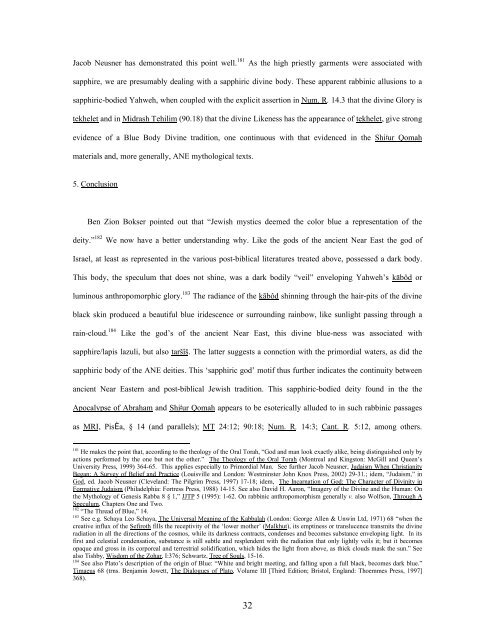Sapphiric God: - Dr. Wesley Muhammad
Sapphiric God: - Dr. Wesley Muhammad
Sapphiric God: - Dr. Wesley Muhammad
Create successful ePaper yourself
Turn your PDF publications into a flip-book with our unique Google optimized e-Paper software.
Jacob Neusner has demonstrated this point well. 181 As the high priestly garments were associated with<br />
sapphire, we are presumably dealing with a sapphiric divine body. These apparent rabbinic allusions to a<br />
sapphiric-bodied Yahweh, when coupled with the explicit assertion in Num. R. 14.3 that the divine Glory is<br />
tekhelet and in Midrash Tehilim (90.18) that the divine Likeness has the appearance of tekhelet, give strong<br />
evidence of a Blue Body Divine tradition, one continuous with that evidenced in the Shi#ur Qomah<br />
materials and, more generally, ANE mythological texts.<br />
5. Conclusion<br />
Ben Zion Bokser pointed out that “Jewish mystics deemed the color blue a representation of the<br />
deity.” 182 We now have a better understanding why. Like the gods of the ancient Near East the god of<br />
Israel, at least as represented in the various post-biblical literatures treated above, possessed a dark body.<br />
This body, the speculum that does not shine, was a dark bodily “veil” enveloping Yahweh’s kābôd or<br />
luminous anthropomorphic glory. 183 The radiance of the kābôd shinning through the hair-pits of the divine<br />
black skin produced a beautiful blue iridescence or surrounding rainbow, like sunlight passing through a<br />
rain-cloud. 184 Like the god’s of the ancient Near East, this divine blue-ness was associated with<br />
sapphire/lapis lazuli, but also taršîš. The latter suggests a connction with the primordial waters, as did the<br />
sapphiric body of the ANE deities. This ‘sapphiric god’ motif thus further indicates the continuity between<br />
ancient Near Eastern and post-biblical Jewish tradition. This sapphiric-bodied deity found in the the<br />
Apocalypse of Abraham and Shi#ur Qomah appears to be esoterically alluded to in such rabbinic passages<br />
as MRI, PisÈa, § 14 (and parallels); MT 24:12; 90:18; Num. R. 14:3; Cant. R. 5:12, among others.<br />
181 He makes the point that, according to the theology of the Oral Torah, “<strong>God</strong> and man look exactly alike, being distinguished only by<br />
actions performed by the one but not the other.” The Theology of the Oral Torah (Montreal and Kingston: McGill and Queen’s<br />
University Press, 1999) 364-65. This applies especially to Primordial Man. See further Jacob Neusner, Judaism When Christianity<br />
Began: A Survey of Belief and Practice (Louisville and London: Westminster John Knox Press, 2002) 29-31.; idem, “Judaism,” in<br />
<strong>God</strong>, ed. Jacob Neusner (Cleveland: The Pilgrim Press, 1997) 17-18; idem, The Incarnation of <strong>God</strong>: The Character of Divinity in<br />
Formative Judaism (Philadelphia: Fortress Press, 1988) 14-15. See also David H. Aaron, “Imagery of the Divine and the Human: On<br />
the Mythology of Genesis Rabba 8 § 1,” JJTP 5 (1995): 1-62. On rabbinic anthropomorphism generally v. also Wolfson, Through A<br />
Speculum, Chapters One and Two.<br />
182 “The Thread of Blue,” 14.<br />
183 See e.g. Schaya Leo Schaya, The Universal Meaning of the Kabbalah (London: George Allen & Unwin Ltd, 1971) 68 “when the<br />
creative influx of the Sefiroth fills the receptivity of the ‘lower mother’ (Malkhut), its emptiness or translucence transmits the divine<br />
radiation in all the directions of the cosmos, while its darkness contracts, condenses and becomes substance enveloping light. In its<br />
first and celestial condensation, substance is still subtle and resplendent with the radiation that only lightly veils it; but it becomes<br />
opaque and gross in its corporeal and terrestrial solidification, which hides the light from above, as thick clouds mask the sun.” See<br />
also Tishby, Wisdom of the Zohar, I:376; Schwartz, Tree of Souls, 15-16.<br />
184 See also Plato’s description of the origin of Blue: “White and bright meeting, and falling upon a full black, becomes dark blue.”<br />
Timaeus 68 (trns. Benjamin Jowett, The Dialogues of Plato, Volume III [Third Edition; Bristol, England: Thoemmes Press, 1997]<br />
368).<br />
32
















